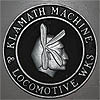Questions & Answers |
Buying & Selling |
General Information |
Klamath
Machine & Locomotive Works:
|
|||||||
 |
| Above. A Klamath Machine & Locomotive builder's plate. Photo courtesy of Amaro Rocha. Click image for larger version. |
Now the controversy centers around the plates that have surfaced with the Klamath Machine & Locomotive "Indian Head" logo on them. Actually, these are more like labels than true builders plates because they do not have a unique number and/or other identifying information typical of locomotive builders plates. Consequently there is no way to determine if a given plate came off a locomotive or some other piece of industrial equipment. Anyway, there is consensus that some plates are real, but various reports have suggested that they have also been reproduced. So the problem is telling the real ones from the fake ones. One collector emailed us to say, "Some [of the fakes] are pretty good but some are horrible. The good ones are polished but often have the 2 mounting holes drilled into the face rather than between the letters in the rim as the real ones are." We have not heard of reports that the ashtrays have been reproduced.
Show below are authentic plates and ashtrays, front and back photos. According to the collector who sent these to us, the plate is from one of a Shays rebuilt by Klamath Machine & Locomotive Works in the 1930's. Click on any image for a larger version.
 |
 |
 |
 |
In late Spring, 2006, we received the following comment:
"Regarding your request for information regarding KMLW . . . You are correct in your dates about the existance of the firm. Klamath specialized in machinery for the lumber industry, but because of the availability of large casting, forging and machining capabilities, often ventured into other industries via contract work. A lot of this work took the form of rebuilding railroad equipment for not only small, but larger West Coast railroads.
I was the maintenance superintendent in a large Washington sawmill back in the 1970s and one of our secondary breakdown machines (a resaw) was a 7-foot high-strain bandmill manufactured by KMLW in 1937. It was a fine machine. The nameplates (2) were mounted on the column frames featuring the Indian Head Logo shown in the photographs on your web site. However, the plates were not painted and were cast iron - secured by two screws.
In my files at the plant were complete drawings for the bandmill as well as a 1956 catalog describing the company. These were still in the record when I left the plant which has since closed. Several photographs showed locomotive cylinders and steamchests being rebored/reported." - EMW
Special thanks to the individuals who have provided images and information!